Disclaimer: This product was sent to us for free, in exchange for a review. We were not paid by Jackery to do this review but we did receive it for free. All opinions expressed in this post are based on our personal views and experiences.
Is The Jackery Explorer 1000 The Best Power Station/Solar Generator?
When Jackery released the Explorer 1000 (click to view on Amazon), I was one of many who said – Finally, a Jackery power station with USB C and an MPPT charge controller.
We had seen power stations, also known as solar generators, released by other brands with these features so it wasn’t a surprise that Jackery added them to their newest portable battery as well.
But there is more to a power station than a USB C port and an MPPT charge controller, so how does it hold up against the competition, and what is it good, and not so good at?
That’s what we’re going to find out in this full review of the Jackery Explorer 1000.
Related: Review Of The Jackery Explorer 1500 Power Station/Solar Generator
What Is a Power Station/Solar Generator?
A portable power station, also known as a solar generator, is basically an all-in-one box with a battery, an inverter, a charge controller, and a couple of other components.
The battery stores the electricity and its capacity is usually advertised in watt-hours.
For example, 100 watt-hours mean that you can run a device at 100 watts for one hour. The Explorer 1000 can store 1002 watt-hours.
Related Post: Goal Zero Vs Jackery
The inverter changes the 12V DC battery power to 110V AC power so you can plug devices, appliances, and chargers into the power station that you usually plug into wall outlets in your home.
The charge controller makes it possible to connect solar panels directly to the input port on the power station to recharge the battery.
Since the charge controller is built-in, you shouldn’t connect a solar panel that has an external charge controller.
The same port you plug solar panels into is also used for the wall and car charger.
You can also recharge a power station with a regular gas generator, and in that case, you use the wall charger.
Who Is The Explorer 1000 For?
As someone that travels full-time and spends most of the time camping out in the boonies far from hookups and the grid, portable power stations have become an essential utility in our lives.
My wife and I work full-time online, so we need to be able to power our laptops, our coffee maker, chargers of all sorts, and our TV at night.
Sure, we could turn on the generator in the morning and run it all day, but then we would not only have to fill it up and buy gas several times a week, but the noise would drive us nuts.
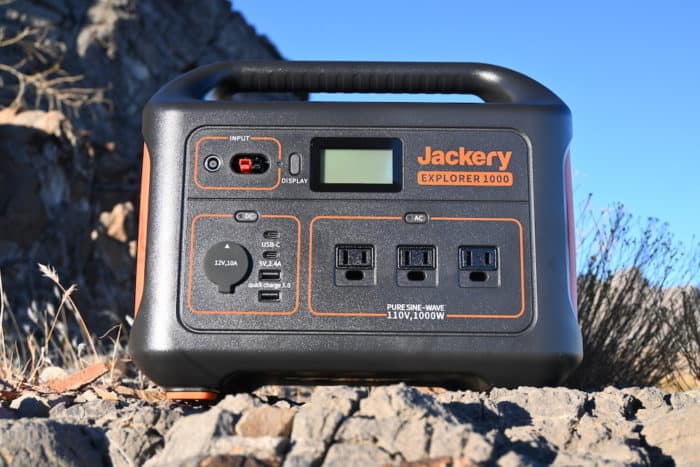
For us, a portable power station/solar generator like the Explorer 1000 is perfect.
All we have to do when we get to a campsite, no matter where we are, is to set up the solar panels outside, hook up the cables, and the battery will start charging.
When we need to charge our laptops or make a cup of coffee, all it takes is the push of a button to turn the inverter inside the Explorer 1000 on, and it’s ready to provide a charge or power our devices.
There is a fan that turns on to keep the inverter in the power station cool, but it’s not nearly as noisy as the sound of a gas generator.
Our Review Of The Jackery Explorer 1000
Now that we know the basics about power stations, let’s dive into our review of the Explorer 1000.
Features
Battery Capacity
The Explorer 1000 has a battery capacity of 1002 watt-hours.
If you take the inverter efficiency into account (85%), that means that you can power a 100W device for about 8.5 hours.
Inverter
The pure sine wave inverter in the Explorer 1000 can output up to 1000W continuously.
That makes it powerful enough to power small coffee makers, small space heaters, small electric grills/toasters, pressure cookers, blenders, and other small kitchen appliances.
1000W is more than enough to power TVs, gaming consoles, desktop computers, fans, portable fridges/freezers, and home theaters.
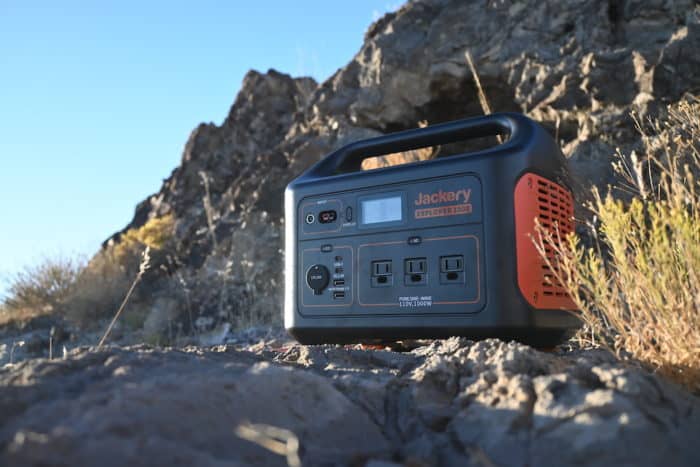
It’s not quite powerful enough to power air conditioners, large space heaters, and microwaves.
If you’re an RVer, you can plug your whole RV or camper into the Explorer 1000 with an adapter.
We plug our 30A travel trailer into the Jackery with a 15A to 30A adapter.
When plugged in, the Explorer 1000 charges our trailer batteries and keeps the outlets powered so we can watch TV and charge our laptops as if we were hooked up to shore power.
It can power everything but the microwave and air conditioner.
Ports
The Explorer 1000 has a lot of ports that can be used to power several devices at once.
To start with, the 1000W inverter powers the three AC outlets.
Note that these can output 1000W combined, not each. Since it’s a pure sine wave inverter, it can safely power sensitive electronics without issues.
Next to the AC outlets, there are several types of DC ports. Two USB A, two USB C, and a regulated 12V output.
One of the USB A ports is a 3.0 quick charge port, while the second one is a regular USB A 12W port.
The USB C ports can output up to 15W, and the 12V port can output up to 120W (10A).
One of the USB C ports (the top one) is a USB C PD port so it can charge newer laptops that support USB C PD charging, although not very fast.
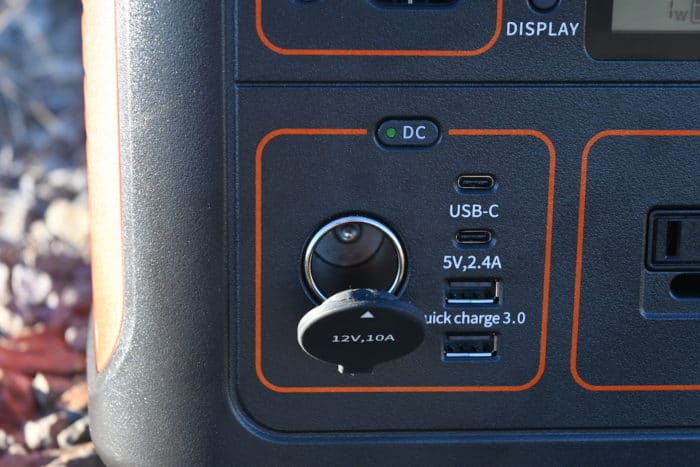
Since the 12V output is regulated, it’s safe to use to power 12V fridge/freezers even when the battery is running low.
Above the AC and DC ports, there are two buttons to turn them on and off.
If you’re not using any of the outlets, you should keep the ports turned off to not waste any electricity.
There are also two ports above the DC ports, and these are the input ports.
There is one 8mm port and one Anderson port. If you have a SolarSaga panel, you’ll plug it into the 8mm port.
If you have two SolarSaga 100W panels, you can plug them into the Anderson port with the 8mm to Anderson combiner cable that Jackery includes with the Explorer 1000.
Combining two solar panels will charge the battery much faster compared to a single panel.
The 8mm port is also used to recharge the battery with the included wall and car charger.
Charging/Solar Capabilities
With the included wall charger (163W), the Explorer 1000 recharges in about 7 hours. That is also how long it takes to charge it with a gas generator since you’ll use the same wall charger.
Related Post: How To Use Third-Party Solar Panels With Jackery Power Stations
It takes about 14 hours with the included car charger (80W), and 17 hours with a single 100W solar panel. With two 100W panels, it only takes 8 hours.
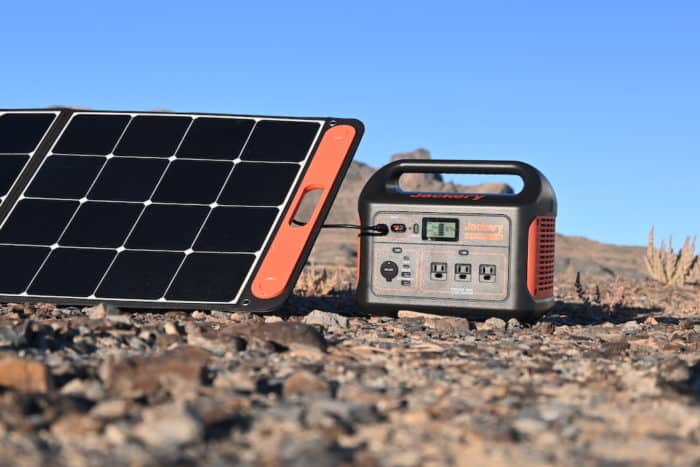
Only one of the charging ports can be used at once, and the fastest you can charge the battery is with the wall charger.
Even though it has an MPPT charge controller, the highest input you’ll get from one or several 12V solar panels is 126W.
The Screen
A screen on the front of the Explorer 1000 shows input and output watts. It also shows the battery percentage and battery bars so you can easily track the battery level.
A button next to the little monitor turns on the backlight to make it easier to read the display.
When the battery reaches 20% and 10%, the screen starts to blink as a warning that the battery is running low.
Other
All of the output ports can be used while the battery is charging.
The built-in handle on top is not foldable but makes it easy to transport and carry the power station.
The Jackery Explorer 1000 weighs 22 pounds and measures 13.1 by 9.2 by 11.1 inches.
Since its battery capacity is larger than 99Wh, it’s not allowed on airplanes.
On the side of the body, there is a built-in flashlight. It’s turned on by a button next to the light, and it can be either on, off, or on an SOS mode where it flashes.
In The Box
Jackery includes a wall charger, a car charger, a SolarSaga Y Parallel cable for combining two Jackery 100W panels, and a user guide.
What I Like
Ports, Lots Of Ports
Some power stations don’t have enough ports, and I think Jackery knows this because the Explorer 1000 has a very good selection of ports.
With three AC outlets, two USB C, two USB A, one 12V port, and two different input ports, it’s compatible with a lot of devices and solar panels.
I especially like that it has three AC outlets, so I don’t have to use a power strip to power several 110V devices.
Now my wife and I can keep our laptops plugged in while also connecting a portable fan, for example.
It might not sound like a big deal, but if you deal with the power station every day, the constant plugging in/unplugging of cables becomes an inconvenience.
MPPT Charge Controller
With an MPPT charge controller, the battery will charge quicker, more efficiently, and in worse conditions.
Related Post: Which Solar Panels Are Compatible With Jackery Explorer Power Stations?
I’m glad Jackery decided to put an MPPT charge controller in the Explorer 1000 to make it a great competitor to the alternative power stations/solar generators on the market.
The Screen
After relying on portable power stations full-time for over a year, I have decided that they absolutely need to have a battery percentage, so thanks Jackery for including that on the Explorer 1000’s screen.
By having an exact percentage (even though it’s not 100% accurate on some power stations) it’s so much more usable and reliable since it lets you track the battery level both when it’s charging and discharging.
But the screen doesn’t only show a battery percentage, it also shows battery bars which might raise some questions as to why it’s needed when there is a percentage, but I have actually found a reason why it’s great to have both.
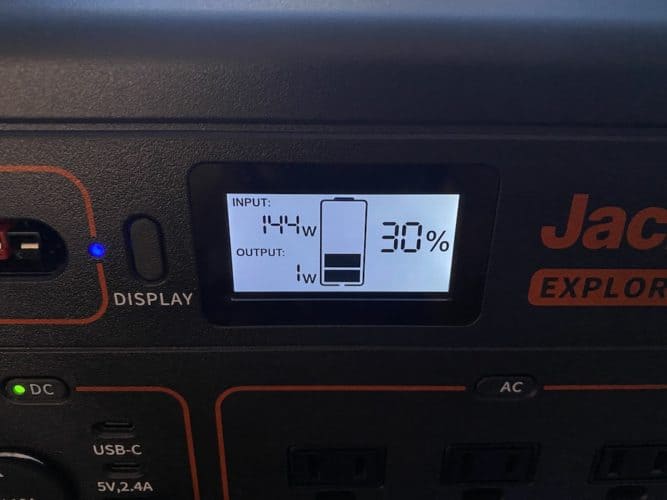
If you’re sitting far away from the power station to where you can’t read the percentage, the battery bars are often easier to read so you can still get an estimate of how much battery is left. It’s a small detail, but it’s nice to have both.
Last but not least, the screen tells us the input and output watts which is another necessity on a power station like this.
It lets you track how good your solar panels are doing, how much electricity your electronics are using, and it makes it easy to calculate how long you’re going to be able to power your devices.
It Can Run A Coffee Maker
Not all power stations are created equal, so I love the ones that are powerful enough to run a coffee maker.
I have a small and portable Black+Decker coffee maker that uses 500-600W, and it runs fine with the 1000W inverter in the Explorer 1000.
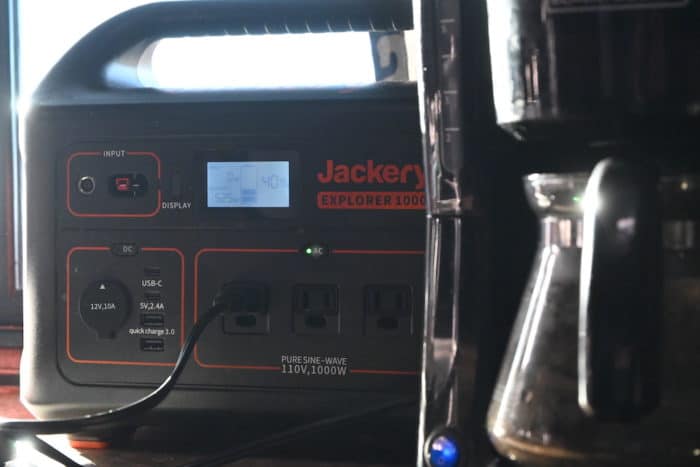
Regulated 12V Output
A regulated 12V output will output a constant voltage that isn’t affected by the battery level until the battery runs out of juice completely.
A common feature on portable 12V fridge/freezers is a low-voltage cut-off that shuts the appliance off when it senses a voltage that is too low to run the fridge/freezer safely without the risk of damaging it.
An unregulated 12V output is therefore not a good source of power for these appliances.
But a regulated 12V output like the one found on the Explorer 1000 (and Jackery’s other power stations for that matter) is an excellent source that will keep it powered safely.
In my opinion, a regulated 12V output is a necessity on a portable power station in 2020, since they’re often used by travelers with a portable 12V fridge, so Jackery has done a great job here.
Portable
The Explorer 1000 only weighs 22 pounds while packing 1002 watt-hours and a 1000W inverter.
In comparison, the similar Goal Zero Yeti 1000 weighs 40 pounds and has a 1045 watt-hour battery capacity and a 1500W inverter.
Is the extra 18 pounds worth it for the extra 500W inverter? That’s up to you.
The portability of the Jackery Explorer 1000 is one of its biggest selling points, in my opinion, and if you don’t need more than a 1000W inverter, it’s possibly the best one on the market in terms of portability.
What Jackery Includes
Jackery includes not only the wall charger but also a car charger. That’s not something that every manufacturer includes.
They also include an 8mm to Anderson combiner so you can combine two SolarSaga 100W solar panels to charge the battery faster.
What I Don’t Like
Slow USB C
I was happy to see two USB C ports on the Explorer 1000, but the fact that they can’t output more than 15W is a shame.
Sure, that’s faster than the 12W you get out of the USB A ports usually, but they need to be faster.
They should’ve been at least 45W, but preferably 60W or 100W. Now they’re not very useful unless you only need to charge small devices like phones and tablets.
My Macbook can be charged via USB C, so a 60W USB C PD port would’ve been great since it would’ve offered a higher efficiency charging port than the AC outlets.
Could’ve Had Faster Charging
It’s great that it has an MPPT charge controller and comes with a relatively fast wall charger, but it could’ve been faster.
The fastest you can charge the Explorer 1000 is in 7 hours, which puts it near the bottom in terms of charging speed when compared to its competitors.
Also, the 126W maximum solar input means that you can’t even utilize all of the electricity that two SolarSaga 100W generate.
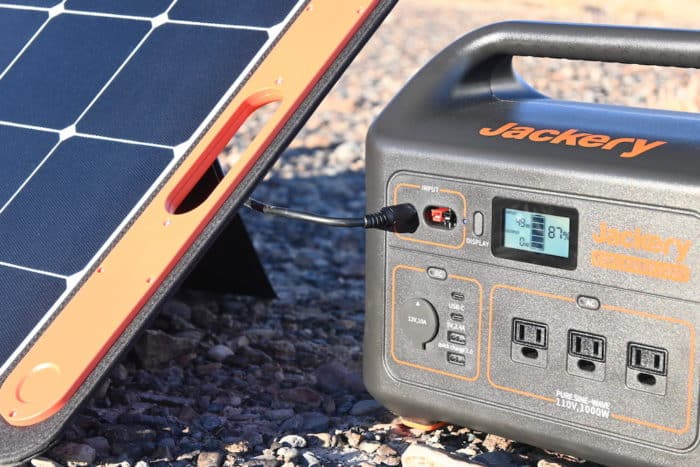
If I plug 200W of solar into my Yeti 1000 MPPT charge controller, it reads 143W. If I plug the same cable into the Explorer 1000, it shows an input of 118W.
Can’t Leave Display Turned On
The display button will light up the display, but not for long. I wish it would stay on until I push the button again.
My reasoning is because it can be hard to read the display when it’s dark, and being able to leave the display on would make it more usable in those scenarios.
Now I have to go push the button to check the battery level.
Conclusion
The power stations/solar generators made by Jackery are popular for a reason. They have a lot of what people are looking for, in a portable package, and they perform well.
There are more things that I like than dislike about the Explorer 1000, and for a lot of people, it’s the perfect power station.
I see the improvements Jackery has made when comparing it to the Explorer 500, but I also see things that it can improve with the next model, as always with new technology.
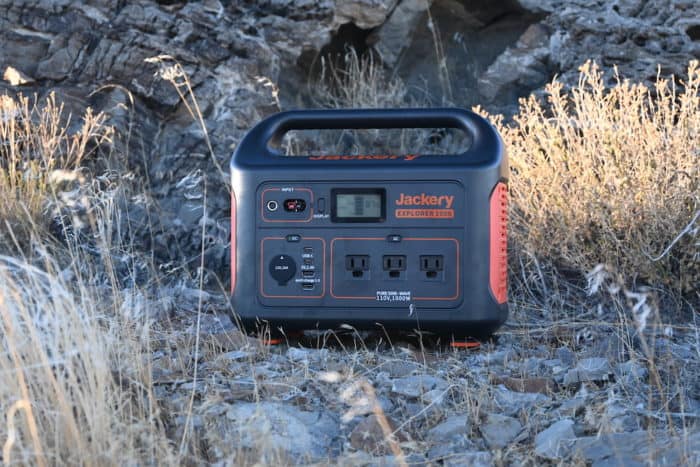
It’s a reliable power station, and as long as you know its features and limitations, you’re going to be happy with it.
And it’s not just for RVers or vanlifers, it’s an excellent option for a backup battery to keep at home in case of emergencies if the power goes out.
With a lot of ports, a regulated 12V output, a screen that gives you the most important information to be able to monitor what’s going on, and several different ways to recharge.
It’s a great affordable portable power station with a lot of battery capacity and power.
Paired with 200W of solar, it will keep your devices charged and powered, and you won’t have to worry about running out of gasoline as with a gas generator.
Frequently Asked Questions
Can the Jackery Explorer 1000 Be Used While It’s Charging?
Yes, all ports can be used while the Explorer is charging. Note that only one of the input ports can be used for charging at once.
UPS Support?
It doesn’t support true pass-through charging as a UPS does, but you can use it as a UPS as long as you make sure that you stay below what the wall charger can generate to the battery.
Are Solar Panels Included?
No, solar panels are not included with the Jackery Explorer power stations.
How Do I Make The Battery Last Longer?
Jackery advertises 500 cycles to 80% battery capacity, and one way to increase that is to keep the battery above 20% and below 80% charged.
It’s also recommended with lithium batteries to recharge them as soon as possible and not leave a depleted battery for very long.
Jackery recommends keeping the battery charged when in storage, but if you use it weekly, I would keep it between 20-80% to extend the life of the battery.
Can You Plug An RV/Camper Into The Explorer 1000?
Yes, I have done this myself with an a 15A to 30A adapter (click to view on Amazon).
If you have a 50A RV/camper, you’re going to need a 15A to 50A adapter (click to view on Amazon).
There are different adapters depending on what the cord or outlet on your camper looks like, but it needs to be a regular 15A plug on the other side that you’ll plug into one of the AC outlets on the Explorer 1000.
Remember that even though you’re plugging a 50A trailer into power doesn’t mean that the outlet it’s receiving power from supports 50A.
Just like when you plug an RV into an outlet in a garage, which usually is 20A, you need to know what you can and can’t run.
The 1000W inverter in the Explorer will not run the air conditioner or the microwave, but smaller devices like TVs, chargers, CPAP machines, fans, and similar devices.
Will It Power My Device?
Most devices and appliances have stickers or power bricks that tell you how many watts it uses. I use a Kill-A-Watt (click to view on Amazon) so I know exactly.
If it only tells you volts and amps, you can multiply them to get a wattage estimate.
When you know how many watts a certain device uses, you’ll know whether it can be powered by the Explorer 1000 or not since we also know that the Jackery can output up to 1000 watts continuously.
In general, 1000 watts is not powerful enough to power a microwave, an air conditioner, or large space heaters.
If you have any questions about the Explorer 1000 or think it’s not quite powerful or enough for you, please leave a comment, and I will do my best to helpght power station/solar generator you find the ri.


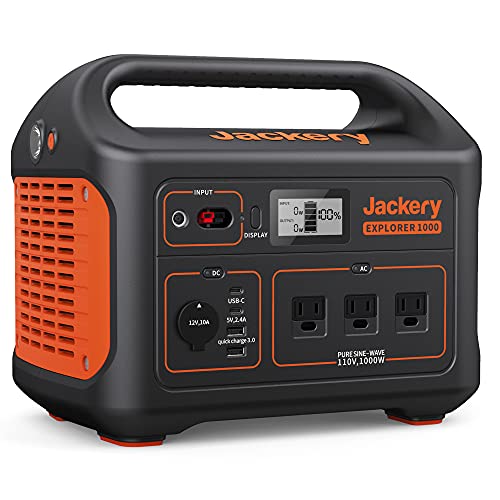
Hi,
Do you have an idea how the Jackery 1000 compares to the HomePower ONE: Emergency Power Supply | Backup Battery Power Station from General. Seems like the same thing. Just more bucks and a folding handle.
https://generark.com/products/homepower-one
Hey Chris,
Yep, looks like the exact same thing in a different shell.
Jesse
Hi Jesse,
I just purchased a 175W flexible Renogy solar panel and the recommended 8mm adapter. Have you tried this configuration and what are your thoughts?
Thanks,
Scott
Hey Scott,
I haven’t tried the 175W specifically, but I have tested a similar 200W panel and it worked great. It’s a great setup! A 175W panel should get close to the 126W limit of the Explorer 1000.
Great info here! I’m a newbie and trying to decide what solar set up I need.
I have a 1977 renovated (I did not do the work) 13’ Scamp trailer.
There is no battery, just shore power. On board there is a water pump, 1-light, a Bosch water heater. I need to have enough power to run a small fridge/cooler, fan, small space heater, hot plate, and a microwave if possible + Recharge a phone/iPad… I’m wondering if the Jackery 1000 is overkill? I’m planning on simply plugging the shoreline into the Jackery. I realize I would never run all these things at once… light, fridge, cooler/fridge would be the most used.
And here’s the dumb question: how do you run the shoreline cord, which is thick, back into the camper so you can keep the Jackery safe and plug it in? There is a lockable metal storage box sitting on the trailer in front of camper… it that a better place to stash the Jackery? But there I cannot see the info panel…
Your thoughts and guidance are greatly appreciated!!
Hey Kim,
Space heaters, hot plates, and microwaves use a lot of power and the Explorer 1000 might actually not be enough to power those, even if you only do one at a time. But it depends on which heater, plate, and microwave you have so I recommend looking up the wattage info of the devices and appliances you plan on using before buying the Jackery. I have a space heater that uses 700W on low and 1500W on high, so I can only run it on low. My microwave is a 700W output model which requires 1000-1000W so it can just barely run on the Explorer 1000.
When it comes to the wiring, the easiest way is to run an extension cord to the Jackery on the inside. Maybe you could keep the extension cable in a storage compartment and pull it out when you get to camp? It’s hard to say without taking a look at your camper, but I would try to use an existing hole or door to pull the cable into the camper, so you can turn on/off and monitor the power station inside.
Thanks Jesse! I’ll start working on my math…
My new to me Scamp has an AC and water heater (electric) that I will never use without shore power. My main concern is the light, water pump & Coleman cooler. I can use a propane stove to cook without electricity too.
I appreciate all the info here! So helpful! Thanks!!
Sounds good! In that case, the Explorer 1000 might very well be enough!
Ok upon first using the Jackery 1000 for an emergency, it started out out the box at 36%! Am I supposed to charge them first before using?
Hey Bella,
Yes, I believe the manual says you should charge it to 100% before using it the first time.
Jesse, this article was very helpful, and confirmed my decision to go with the Jackery 1000 for my 1966 Airstream Caravel. This provides more information than you get from Jackery – there is no owners’ manual for the unit. Just a quick start-up tutorial, which is a bit unnerving for someone like myself who is not comfortable around electricity.
I am glad you confirmed that the unit can be plugged directly into the shore power inlet, using a pig tail 15 to 30 amp. But, can you leave the solar panels plugged into the unit while you are using it – or do you have to run the whole unit down before recharging with the solar panels. I’d like to be able to leave the panels plugged in during the day (if sunny), so that I have a constant source of power which is similar to being plugged in at the shore power box.
One question I had about one of your responses to Bella. You told her: “I have a space heater that uses 700W on low and 1500W on high, so I can only run it on high.” This response seems counter-intuitive to me, and may explain why I am struggling to understand the wattage limitations of the unit. Could you please illuminate?
Thanks for your help and for keeping it simple.
Hi Flo,
Happy to hear you found the review helpful!
Yes, I leave the solar panels plugged in while also powering my travel trailer. If you use two 100W panels and reach the 126W input limit it will extend the time you can keep it plugged in, but the trailer will most likely use more than 126W even when just charging your 12V camper batteries + whatever you have plugged into the outlets in your Airstream.
Simply put, if 126W are coming in, and 300W are going out, a fully charged Jackery 1000 will last about 4-6 hours.
Thanks for pointing out the error in my respone to Bella, I have edited the comment. I can only run it on low for about an hour.
Appreciate the additional information. I went 100% off grid this weekend, thanks to the sun and some very agile repairs to the LP function on my refrigerator. If all holds, I am good to go, and with options! This may not be the best system out there, but at 22 pounds, and the fact that it will power everything that isn’t on LP, I am pretty pleased thus far – though am already trying to sort how best to leave the unit inside the trailer !
Hi Jesse,
your review on the Jackery was more informative than any of the YouTube videos
Thank you
I have two questions for you and hope you can get to answer, thank you.
1. what noise level does it make when being charged on the wall socket. 230v
2. Can I plug in directly to my UK Touring Caravan okay?
Many thanks Nicola